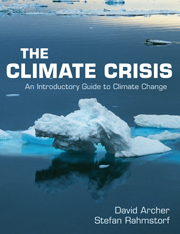Book contents
- Frontmatter
- Contents
- Preface
- 1 Retrospective: what we knew and when we knew it
- 2 Earth's energy budget
- 3 Climate change so far
- 4 Snow and ice
- 5 How the oceans are changing
- 6 The past is the key to the future
- 7 What the future holds
- 8 Impacts of climate change
- 9 Avoiding climate change
- 10 Climate policy
- Epilogue
- References
- Illustration credits
- Index
2 - Earth's energy budget
Published online by Cambridge University Press: 05 March 2013
- Frontmatter
- Contents
- Preface
- 1 Retrospective: what we knew and when we knew it
- 2 Earth's energy budget
- 3 Climate change so far
- 4 Snow and ice
- 5 How the oceans are changing
- 6 The past is the key to the future
- 7 What the future holds
- 8 Impacts of climate change
- 9 Avoiding climate change
- 10 Climate policy
- Epilogue
- References
- Illustration credits
- Index
Summary
This chapter explains the greenhouse effect, and the various changes to the greenhouse effect that can affect Earth's energy budget, and therefore its climate. Greenhouse gases are the obvious change that we read about in newspapers, but other factors include changes in the amount of small particles in the air, called aerosols, and changes in the intensity of the sun. Knowing something about the causes of climate change so far will enable us to decide whether global warming has already started, or whether the warming that has been observed on Earth in the last decades could have natural causes. This chapter is based on IPCC Chapter 2, “Changes in Atmospheric Constituents and in Radiative Forcing” and Chapter 7, “Couplings between Changes in the Climate System and Biogeochemistry.”
The concept of radiative forcing
The climate of the Earth is governed by the very fundamental First Law of Thermodynamics. This is the law of energy conservation: energy cannot appear from nowhere, nor can it vanish into nothingness. Earth's climate is ruled by a very simple and fundamental principle: “energy coming in must go out.” Energy comes in by way of sunlight, mostly in the form of visible and ultraviolet (UV) light. Energy travels back out to space via infrared light shining up from the Earth's surface and atmosphere.
The Earth's energy fluxes in and out can be wildly out of balance at any given instant or location, but on average for the entire planet and over a long time, the energy fluxes must balance.
- Type
- Chapter
- Information
- The Climate CrisisAn Introductory Guide to Climate Change, pp. 16 - 38Publisher: Cambridge University PressPrint publication year: 2009



